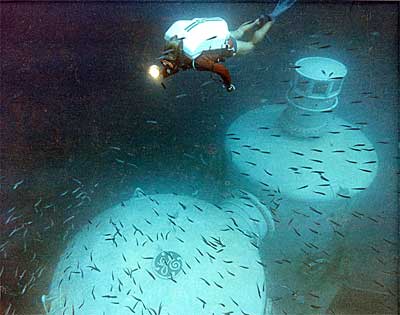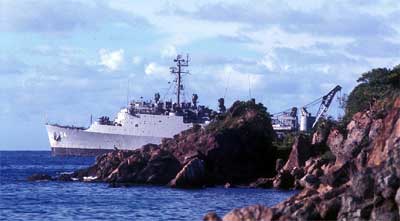Tektite Program Overview
carrying the ‘Habitat’ and other support materials and
elements arrives in Lameshur Bay, January 1969.
Forty years ago next month, February 15th, 1969, the underwater program known as Tektite I was just beginning, right here on St. John — just off the south shore, and to the north–west of Cabritte Horn Point, in Great Lameshur Bay.
Four Department of Interior marine scientists would descend to a depth of approximately 50 feet and would reside and work there for the next 60 days—longer than any human being had ever lived and worked under the sea.
For the United States, this was a nationally significant program designed to—
- advance our knowledge of man’s ability to withstand long periods of high pressure caused by being submerged,
- enhance the breadth of our understanding of the marine environment,
- and better prepare ourselves for the anticipated extended space travel that would follow.
This highly complex undertaking, which drew on much of the existing scientific knowledge of the day, was backed jointly by the Navy, NASA, the Department of Interior, the Missile & Space Division of the General Electric Company, and it relied on the expertise of many of this country’s leading scientists and pioneers in their respective fields.
The decade of the 1960s was one of great contrasts for our Nation. It was a turbulent and stressful time, but out of all of this or perhaps because of all this it was a decade in which great strides forward were made in both science and technology. The Tektite program was the product of this era and it greatly advanced our knowledge of both the sea and our ability to live and work in a hostile and confining environment for a prolonged period.

Aquanaut with advanced breathing gear swims above
living quarters–the ‘Habitat’–anchored at a 49 foot
depth below the surface of Lameshur Bay.
Following the success of the initial Tektite program in 1969, a subsequent equally successful program, known as Tektite II, was carried out over a seven month period in 1970. This program allowed for more diverse and in depth marine scientific studies than the first, would attempt extended stays at a greater depth and test and evaluate more sophisticated diving equipment. It would also employ and benefit a wider variety of governmental agencies, academics and the industrial community. This was accomplished through 11 separate missions, most with a duration of from 13 to 20 days, in which 53 aquanauts took part, including both an all women’s team and a number of international participants.
It should be noted that the physical structures comprising what we know today as the Virgin Islands Environmental Resource Station (VIERS) at Lameshur Bay—were actually built by the Navy Seabees, and served as the base station for the entire Tektite program.

